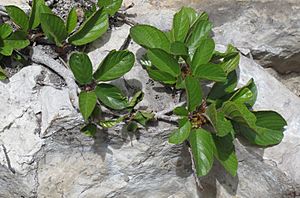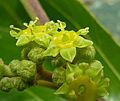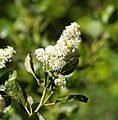Rhamnaceae facts for kids
Quick facts for kids Rhamnaceae |
|
|---|---|
 |
|
| Rhamnus pumila | |
| Scientific classification |
The Rhamnaceae is a big family of plants. It includes many different kinds of trees, shrubs, and even some climbing vines. There are about 55 groups, called genera, and around 950 different species in this plant family.
You might know some plants from this family already. For example, the jujube fruit comes from a plant in the Rhamnaceae family. Another interesting one is Hovenia dulcis, also known as the Japanese raisin tree.
Contents
What are Rhamnaceae Plants?
The Rhamnaceae family is part of a larger group of plants called Rosales. These plants are found all over the world. They grow in many different places, from warm tropical areas to cooler regions.
Most plants in this family are woody. This means they have strong stems and branches, like trees and shrubs. Some are small bushes, while others grow into tall trees. A few are even vines that climb up other plants.
Where Do Rhamnaceae Grow?
You can find Rhamnaceae plants on almost every continent. They are very adaptable. Some species prefer dry, sunny places. Others like forests with more shade and moisture. This wide range of habitats shows how diverse the family is.
For example, some types of Ceanothus (also called California Lilac) grow in dry, sunny parts of North America. Meanwhile, other Rhamnaceae species thrive in the rainforests of Australia or South America.
What Do Rhamnaceae Look Like?
Plants in the Rhamnaceae family have different features. Their leaves are often simple, meaning they are not divided into smaller leaflets. They can be arranged in different ways along the stem.
The flowers of Rhamnaceae plants are usually small. They often have five petals, but sometimes four. These flowers can be green, yellow, or white. They might not be very showy, but they are important for making seeds.
After the flowers, these plants produce fruits. The fruits can be berries, capsules, or drupes. A drupe is a fleshy fruit with a hard pit inside, like a cherry. Many of these fruits are eaten by birds and other animals.
Cool Plants in the Rhamnaceae Family
Let's look at a few interesting members of this plant family.
Jujube (Ziziphus jujuba)
The jujube tree is famous for its sweet, edible fruits. These fruits look a bit like dates when dried. They are popular in many parts of Asia. People eat them fresh, dried, or use them in desserts and teas.
Jujube trees are very tough. They can grow in dry areas and are quite resistant to different weather conditions. This makes them important food sources in many regions.
California Lilac (Ceanothus)
Ceanothus is a group of beautiful shrubs and small trees. They are mostly found in North America, especially in California. They are known for their amazing clusters of blue, purple, or white flowers.
These plants are important for wildlife. Their flowers provide nectar for bees and other insects. The seeds are also a food source for birds.
Buckthorn (Rhamnus)
The genus Rhamnus includes many species, often called buckthorns. Some buckthorns are used in traditional medicine. However, some species, like common buckthorn, can be invasive in certain areas. This means they grow very fast and can take over natural habitats.
Why Are Rhamnaceae Important?
Rhamnaceae plants are important for several reasons.
Food and Medicine
As mentioned, some Rhamnaceae fruits like jujubes are eaten by people. Other species have been used in traditional medicine for their properties. For example, some buckthorn species have been used as laxatives.
Ecosystem Role
These plants play a vital role in their ecosystems. They provide food and shelter for animals. Their roots help to hold soil in place, preventing erosion. Many species are also important for pollinators, like bees, which help other plants grow too.
Wood and Other Uses
The wood from some Rhamnaceae trees is used for various purposes. It can be strong and durable. For example, some species are used for making tools or small furniture.
Images for kids
-
Flowers of Ceanothus cuneatus
-
Flowers of Ziziphus mucronata
-
Ceanothus papillosus var. roweanus at the Regional Parks Botanic Garden, Berkeley, California
See also
 In Spanish: Ramnáceas para niños
In Spanish: Ramnáceas para niños







